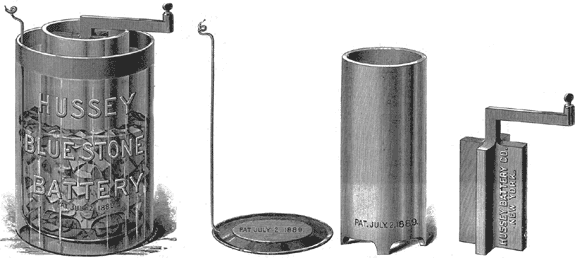[Trade Journal]
Publication: Electrical World
New York, NY, United States
vol. 14, no. 18, p. 295-296, col. 3,1
The New Hussey Battery.
Since the invention of the Daniell battery, which is the first and original form of the bluestone cell, scientists, inventors and chemists have endeavored to prevent the deposit of copper on the zinc plate, but have never succeeded altogether, all admitting that if this could be accomplished the cell would be a theoretically and practically perfect one.
The Hussey bluestone battery which we illustrate in the accompanying figures accomplishes this perfectly, it is claimed, preventing all deposit of copper on the zinc plate which remains bright and clean, the cell giving at the same time a much greater current than the older forms of bluestone battery of the same dimensions, and consequently increasing its field of usefulness very largely.
Our engraving. Fig. 1, is a perspective view of the complete cell, as set up ready for use. It consists of an outer glass jar, in which is placed a copper disc forming one plate, represented in Fig. 2, on which rests a porous cup, which is glazed on its outside from top to bottom, thus rendering its sides non-porous, while the bottom, being unglazed, is porous. This cup is shown in Fig 3 and serves to receive the other plate of zinc, Fig. 4.
To charge the cell the bluestone is placed between the glass jar and the porous cup to a little above the centre of the jar, there being a space of about one inch between the porous cup and jar to contain it. To the bluestone in the glass jar is added a solution of sulphuric acid and water, so as to cover the bluestone crystals. In the porous cup is also put a solution of sulphuric acid and water. The zinc plate is an amalgam of zinc and mercury, and hence requires no further amalgamating. As the bluestone is consumed, it feeds downward toward the bottom of the porous cup, where the action takes place, furnishing a constant supply of sulphate of copper solution to the active portion of the cell.
The prominent feature of the battery, namely, the prevention of a copper deposit on the zinc plate, is accomplished by means of the peculiar form of porous cup employed, the sides of which, being non-porous, prevent all endosmose. The fluid in this porous cup is kept at a higher level than that in the glass jar, consequently the pressure on the inner surface of the porous bottom is downward, so that the bluestone solution can never get into the porous cup to come in contact with the zinc. The electromotive force of this cell is 1.1 volt, and its internal resistance .22 ohm.
Some of the principal advantages claimed for this battery are its cleanliness, low internal resistance, economical consumption of zinc and small amount of attendance required. The battery never has to be dismounted, thus saving both time and labor. To keep it in action it is only necessary to feed the-eell with bluestone, and, when required, to draw off the solution in the porous cup with a syringe and. replace it with fresh.
 |
| Figs. 1, 2, 3, and 4. — the New Hussey Primary Battery. |
These cells are already in large demand for charging storage batteries, and have been in use for this purpose for some time by the Gibson Electric Company, the Metropolitan Phonograph Company, Dr. Goodwillie, a surgeon of this city, and many others, and, we understand, are giving satisfaction.
It is proposed to manufacture cells of a size sufficient to charge a set of accumulators capable of running from 25 to 50 lights, thus enabling private individuals to enjoy the luxury and comfort of the incandescent light without the attendant trouble and annoyance in the employment of boiler, engine and dynamo. These cells would be employed to charge the accumulators for, say, 34 hours, which in turn would furnish a strong current, capable of maintaining a number of incandescent lights for, say, 6 hours. The Hussey Battery Company, of this city, the manufacturers of this cell, are now engaged in constructing a plant of this kind suitable for running 30 lights.
The batteries are particularly fitted for telegraphic work of all kinds on account of the large current they are capable of furnishing. They are also claimed to be applicable for either open or closed circuit work, on account of the absence of all local action; and, among other uses are adapted for district and messenger telegraph service, bell work of all kinds, annunciators and burglar alarms, electric door-openers, and motors engaged in performing any light work, such as driving fans, etc.
